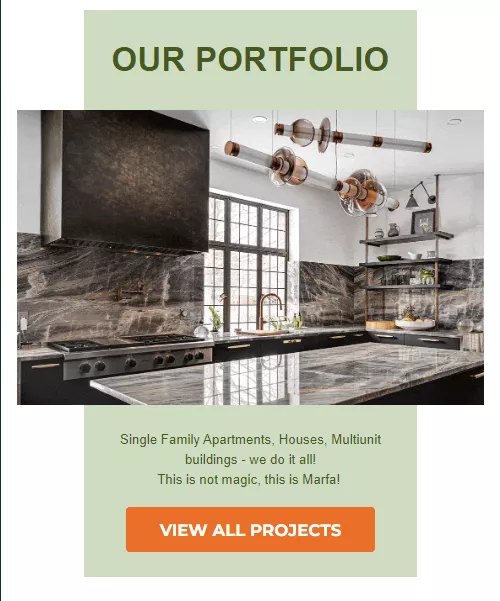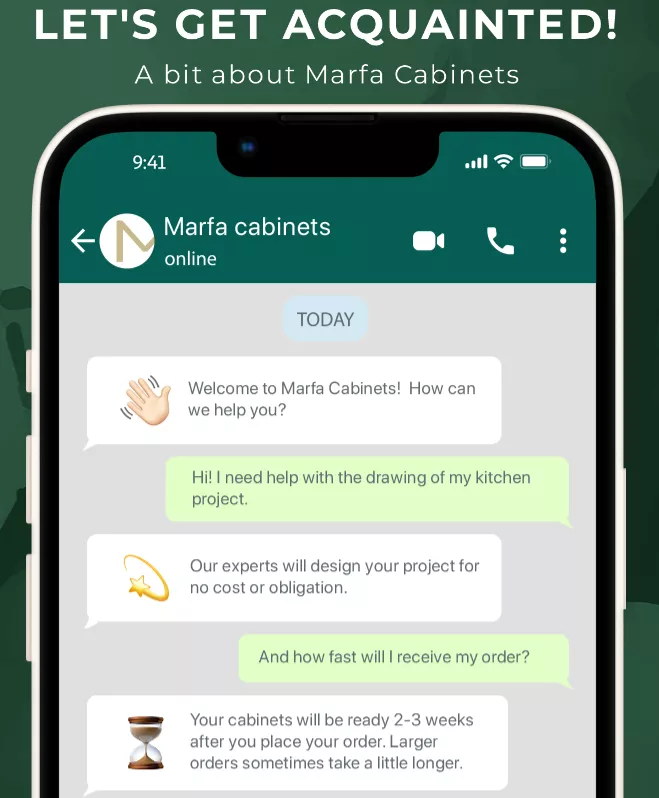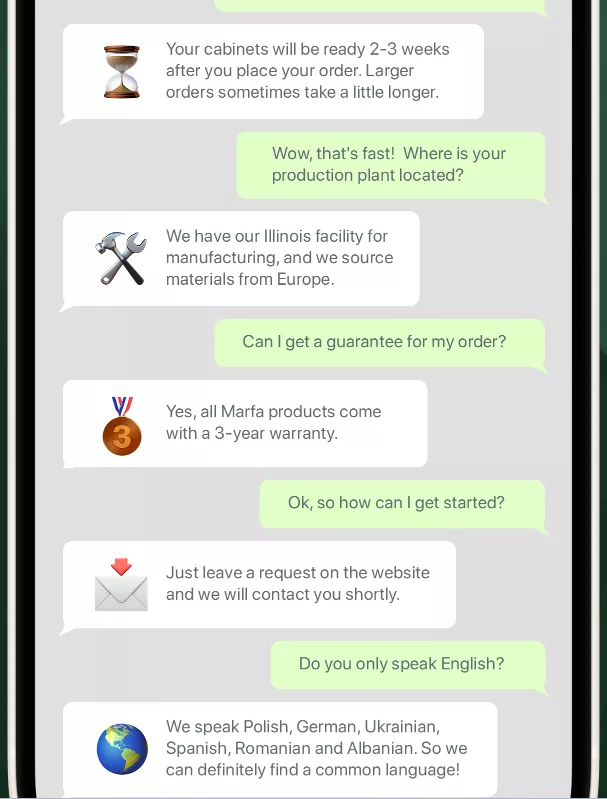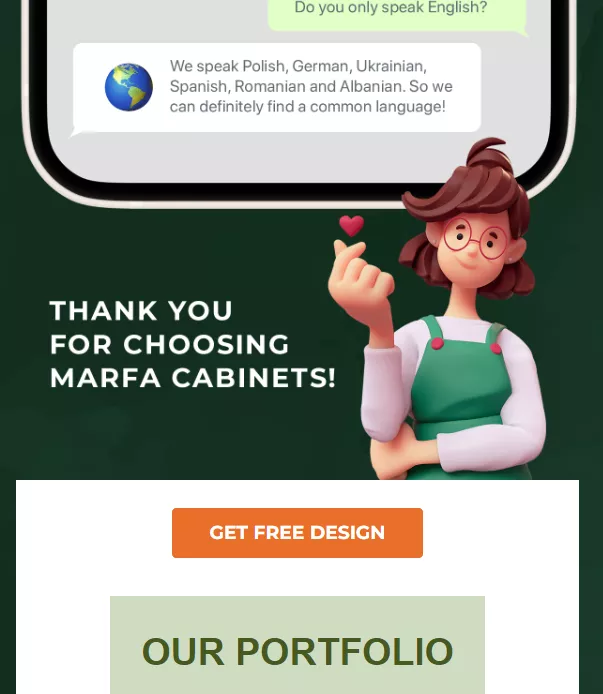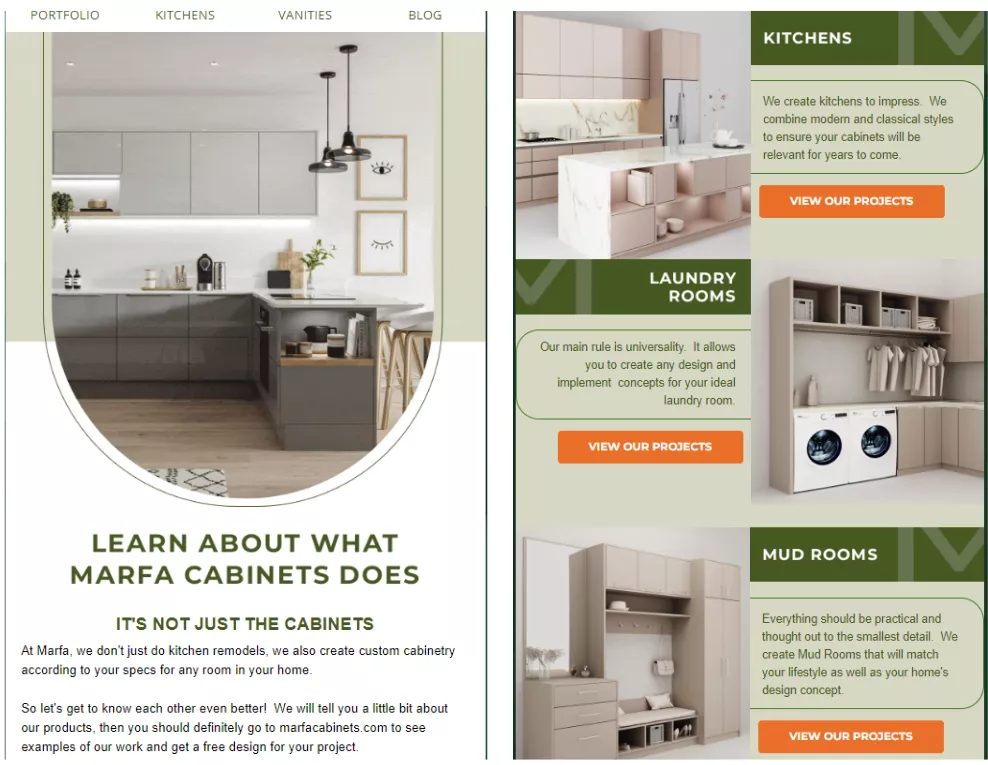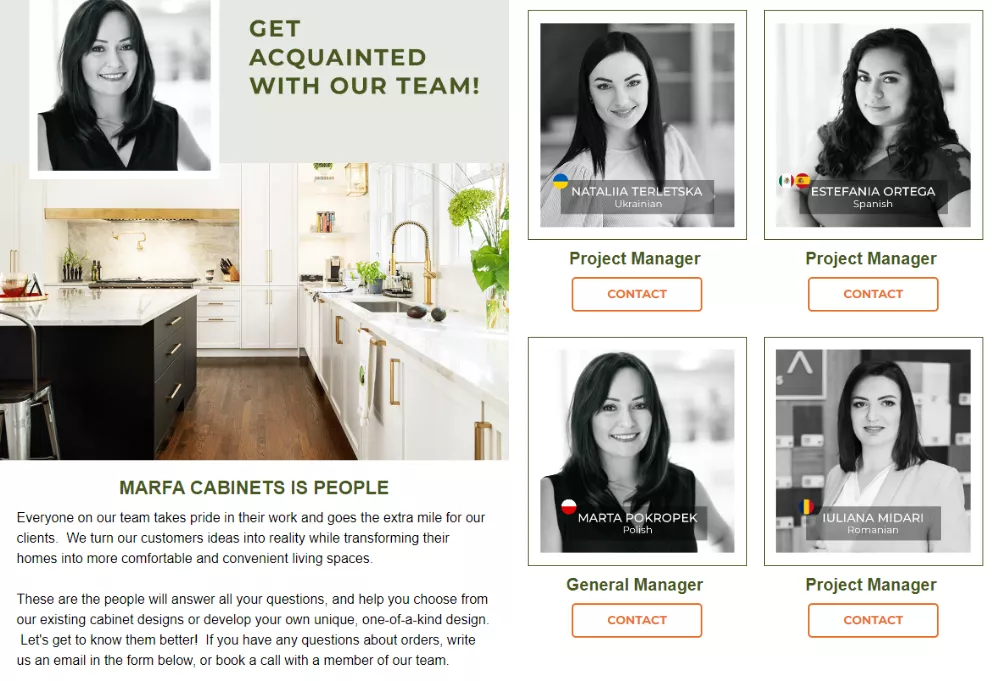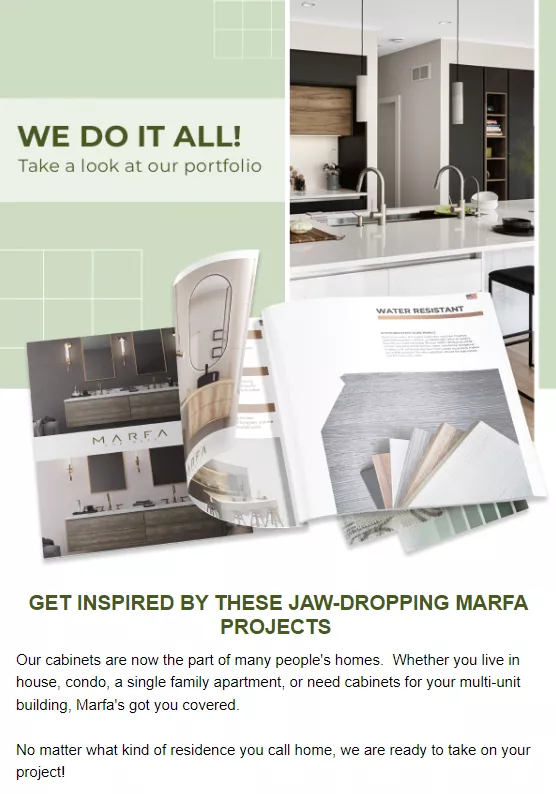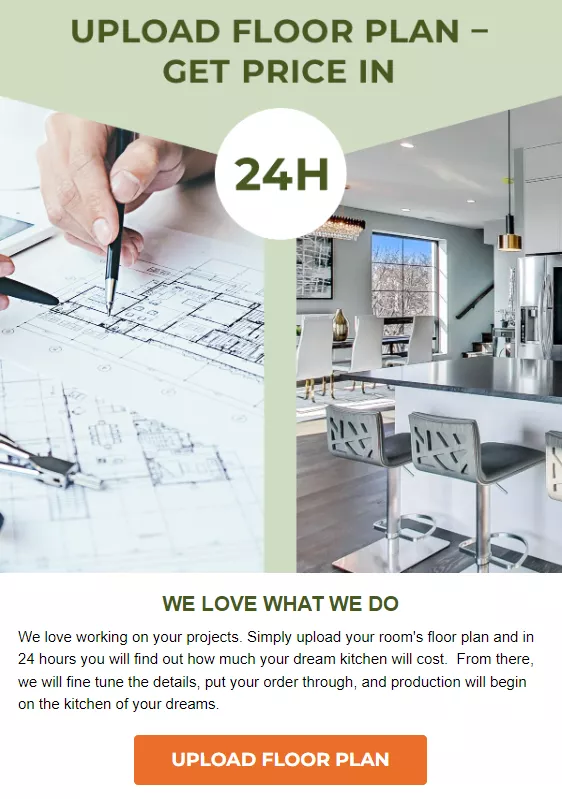Specifics of Creating a Welcome Email Series for a Service Brand: The marfacabinets.com Case Study
Region: USA.
Service: Email marketing.
The Client
Marfa Cabinets is a Chicago-based manufacturer of high-end kitchen cabinets and bathroom furniture. It also specializes in design development for kitchens and bathrooms. Its products are designed and manufactured in the USA using modern materials and equipment.
The Challenge
When the client contacted us, they already had an email channel in place. However, the company had a problem: they lacked communication points with potential customers (subscribers) who were added to the email list after subscribing.
What does this mean? Often, potential customers would visit the website, get interested in the brand, and then subscribe to the newsletter. At the same time, they wouldn’t go as far as filling out a service request due to a lack of information or motivation. At this point, the manager is unable to contact them to explain the service and address any questions they may have. As a result, customers lose interest in the brand over time and forget about it.
There is a simple and effective solution to this problem — proactively initiate communication through a series of welcome emails.
Based on this, we defined the main goals of our work on the project:
- Develop a strategy for a welcome email series.
- Design templates for the triggered email chain.
- Create and launch a trigger script in Hubspot's email service.
The Strategy
A welcome email series is a key component of email communication with customers. Here's a little background on why it's important.
❔A welcome email series is a series of automatic welcome emails that a new customer receives after subscribing to your newsletter. The series allows you to start communicating with a new potential customer in a timely manner before they lose their first interest in the brand. The goal? Motivate them to place an order.
The main benefits of a welcome email series:
- It is one of the trigger chains that brings the most conversions and drives the subscriber to the target action, provided the strategy is correct.
- You will save time and resources in developing and sending bulk emails to introduce the brand.
- It allows you to personalize communications as each contact is influenced by a different funnel. It works automatically and counts the time of sending from the moment of subscription.
When creating the welcome series for marfacabinets.com, we took into account the specifics of the service niche that differentiate it from e-commerce or SaaS:
- A service exists only at the moment of its provision, making it important to prove to the customer that it's easy and convenient to use.
- The process of providing a service is unique and depends on many subjective factors. Therefore, it is important to showcase previous results and successful case studies to prove quality and efficiency.
- Services are provided by people, and the experience and qualifications of specialists are considered important quality indicators. Therefore, it is necessary to introduce the customer to the brand team.
What did our team do?
The goal of the marfacabinets.com welcome series is to create brand loyalty and encourage customers to order furniture. To do this, we needed to increase trust and loyalty and remove any doubts about the process of ordering and receiving products.
To begin, we outlined the following stages of work:
- Update the marfacabinets.com master template for the development of future promotions and triggered emails.
- Conduct a comprehensive analysis of the market, competitors, niche characteristics, target audience, and sales funnel. Based on this, develop a strategy for the welcome trigger series.
- Design trigger templates, and create and integrate a trigger script.
Developing a master email template
A master email template is an email template that matches the style of your website or brand, and it helps you keep all emails consistent in design. The master template contains the necessary blocks that may be needed for different sections, promotions, and newsletters.
Key elements of the new master email template for marfacabinets.com:
- A gif block with project samples and a link to the full portfolio of the company's previous designs.
- A "Why work with Marfa" USP block to highlight the brand's benefits.A "Why work with Marfa" USP block to highlight the brand's benefits.
Designing a welcome email series
We created a welcome series of seven emails. Each of them had a specific goal, which influenced the email design.
The first email
The first goal is to immediately start communicating with a potential customer and introduce the service.
Since a new subscriber is at the stage of getting to know the brand, the first email in the welcome series should provide clear and concise information about the company.
For marfacabinets.com, we used a gif banner to demonstrate the process of creating a kitchen from the early stages of a sketch to the final finished project.
The call-to-action (CTA) button encourages the subscriber to get a free kitchen design by filling out a short form on the website.
The email also includes a portfolio gif block in case the customer needs more time to review past work and make a decision.
The second email
The goal of the next email is to introduce a potential customer to the brand.
The second email should address the customer's initial concerns and demonstrate the benefits of the service.
In the welcome series, we designed the second email as a mockup, mimicking communication with a manager. It was essentially a short dialog based on:
- The most common questions asked by customers
- Answers that dispel certain doubts about the service
At the bottom of the email, we placed a button with the CTA to claim the bonus and a gif block with the brand's portfolio.
The third email
The goal of the third email is to familiarize the customer with the product range.
At this point, potential customers are already familiar with the brand and ready for more information, so it is time to tell them more about the product.
In the third email, we summarized the categories of furniture that can be ordered from marfacabinets.com. We also included buttons with CTAs to go to the website for a more detailed look at each individual category.
The fourth email
The goal of the fourth email is to talk about the company's main advantage, which is the speed of service in the case of Marfa Cabinets, and show examples of previous work.
By the fourth email, the subscriber is already familiar with the brand, the details of the service, the portfolio, and the assortment. For this project, it was time to inform customers about the order processing journey. The subject line of the fourth email emphasized the brand's advantage of fulfilling orders in 21 days.
The email design used a GIF banner to visualize the creation of a new kitchen from sketch to finished product with a countdown timer indicating 21 days.
The fifth email
The goal of the fifth email is to present the team behind the product.
People trust people. The best brand is a name, and one key way to build loyalty in the service industry is to show a team of specialists working on a job.
In the second email of the chain, we mentioned the languages used by managers. This information was further emphasized in the fifth email, which was about getting to know the team.
The sixth email
The goal of the sixth newsletter is to familiarize a potential customer with the company's portfolio.
If the subscriber hasn't filled out the form on the website at this point, it means they need more time to make a decision. During this period, keep communicating with them so they don't lose interest in the brand. It's important that the company stays top of mind and becomes the "first contact" the customer turns to when they decide to place an order.
In the sixth email, we gave the subscriber a "dose of inspiration," showed them previous orders, and once again proved Marfa Cabinets’ expertise in the design niche.
The seventh email
The goal of the final email is to make a special offer and motivate the customer to place an order.
The rationale of this email is based on why customers decline a service. Here are some of the most common reasons:
- They don’t know the price.
- They are unwilling to look for additional information about the brand and its services to find out the cost of the project or the timing of the order.
In the seventh email, we invited the customer to upload their floor plan (since the design process is complex) to a special form on the website and get the cost of the kitchen project within 24 hours.
Final recommendations for setting up a welcome email series
When creating and developing the trigger email scenario, keep the following points in mind:
- The trigger chain should stop as soon as the customer completes the target action, which is filling out the first form for further communication with the sales manager.
- The best intervals for sending emails should be tested, as they vary depending on the niche and brand. However, the intervals should increase gradually from the first to the last so that the first points of interaction with the subscriber are timely. For this project, we used an interval of five minutes after the moment of subscribing to the client's newsletter to send the first email. The next email was sent in two days, the third in four days, and the fourth in five days. All subsequent emails were sent at seven-day intervals.
- At this point, subscribers are not yet loyal enough to receive and read all emails frequently. Therefore, those who receive the welcome series of emails should be excluded from other segments of promotional emails to avoid over-spamming them. This will prevent unsubscriptions, spam complaints, and negative feedback from potential customers.
As you can see, a welcome email series can be a very effective tool for initiating long-term communication with potential customers. Used strategically, these emails will guide them along the user experience path from getting to know the brand to placing an order.
Related Articles
Display Advertising Effectiveness Analysis: A Comprehensive Approach to Measuring Its Impact
In this article, I will explain why you shouldn’t underestimate display advertising and how to analyze its impact using Google Analytics 4
Generative Engine Optimization: What Businesses Get From Ranking in SearchGPT
Companies that master SearchGPT SEO and generative engine optimization will capture high-intent traffic from users seeking direct, authoritative answers
From Generic to Iconic: 100 Statistics on Amazon Marketing for Fashion Brands
While traditional fashion retailers were still figuring out e-commerce, one company quietly revolutionized how U.S. consumers shop for everything from workout gear to wedding dresses




